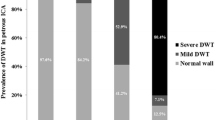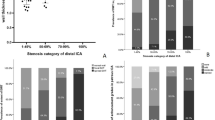Abstract
Purpose
Occlusion or significant stenosis of the internal carotid artery (ICA) in the cervical segment is commonly associated with a poststenotic decrease in the downstream blood flow and perfusion. Fluid attenuated inversion recovery (FLAIR) vascular hyperintensities (FVH) are a phenomenon that represents slow arterial blood flow. In this study, we investigated the frequency and extent of FVH in the distal ICA in patients with proximal ICA stenosis.
Methods
We analyzed the magnetic resonance imaging (MRI) findings in 51 patients with a total of 60 cervical ICA stenoses with special focus on the frequency and extent of FVH in the area of the petrous segment of the ICA on FLAIR images and correlated these with Doppler/duplex sonography results.
Results
In 46 (76.7%) patients with ICA stenosis, FVH could be detected in the petrous segment of the ICA: in 19 (41.3%) patients a thin hyperintense rim near the vessel wall (grade 1), in 24 (52.2%) patients a strong hyperintense rim near the vessel wall (grade 2), and in 3 (6.5%) patients a hyperintense filling of the entire lumen (grade 3) was observed. The extent of FVH in the ICA in the petrous segment showed a high negative correlation with the poststenotic flow velocity (Spearman correlation, R = –0.75, p < 0.001), and moderate correlation with the degree of ICA stenosis (Spearman correlation, R = 0.51, p< 0.001).
Conclusion
An FVH in the petrous ICA is commonly seen among patients with steno-occlusive disease in proximal ICA and could therefore be useful to recognize a proximal ICA stenosis even on FLAIR images.


Similar content being viewed by others
References
Kamouchi M, Kishikawa K, Okada Y, Inoue T, Ibayashi S, Iida M. Poststenotic flow and intracranial hemodynamics in patients with carotid stenosis: transoral carotid ultrasonography study. AJNR Am J Neuroradiol. 2005;26:76-81.
Allen LM, Hasso AN, Handwerker J, Farid H. Sequence-specific MR imaging findings that are useful in dating ischemic stroke. Radiographics. 2012;32:1285-97; discussion 1297-9.
Azizyan A, Sanossian N, Mogensen MA, Liebeskind DS. Fluid-attenuated inversion recovery vascular hyperintensities: an important imaging marker for cerebrovascular disease. AJNR Am J Neuroradiol. 2011;32:1771-5.
Iancu-Gontard D, Oppenheim C, Touzé E, Méary E, Zuber M, Mas JL, Frédy D, Meder JF. Evaluation of hyperintense vessels on FLAIR MRI for the diagnosis of multiple intracerebral arterial stenoses. Stroke. 2003;34:1886-91.
Yoshioka K, Ishibashi S, Shiraishi A, Yokota T, Mizusawa H. Distal hyperintense vessels on FLAIR images predict large-artery stenosis in patients with transient ischemic attack. Neuroradiology. 2013;55:165-9.
Wolf RL. Intraarterial signal on fluid-attenuated inversion recovery images: a measure of hemodynamic stress? AJNR Am J Neuroradiol. 2001;22:1015-6.
Purroy F, Montaner J, Molina CA, Delgado P, Ribo M, Alvarez-Sabín J. Patterns and predictors of early risk of recurrence after transient ischemic attack with respect to etiologic subtypes. Stroke. 2007;38:3225-9.
Förster A, Kerl HU, Wenz H, Mürle B, Habich S, Groden C. Fluid Attenuated Inversion Recovery Vascular Hyperintensities Possibly Indicate Slow Arterial Blood Flow in Vertebrobasilar Dolichoectasia. J Neuroimaging. 2015;25:608-13.
Schellinger PD, Chalela JA, Kang DW, Latour LL, Warach S. Diagnostic and prognostic value of early MR Imaging vessel signs in hyperacute stroke patients imaged <3 hours and treated with recombinant tissue plasminogen activator. AJNR Am J Neuroradiol. 2005;26:618-24.
Arning C, Widder B, von Reutern GM, Stiegler H, Görtler M. Revision of DEGUM ultrasound criteria for grading internal carotid artery stenoses and transfer to NASCET measurement. Ultraschall Med. 2010;31:251-7.
Sanossian N, Saver JL, Alger JR, Kim D, Duckwiler GR, Jahan R, Vinuela F, Ovbiagele B, Liebeskind DS. Angiography reveals that fluid-attenuated inversion recovery vascular hyperintensities are due to slow flow, not thrombus. AJNR Am J Neuroradiol. 2009;30:564-8.
Bayliss L. The rheology of blood. Baltimore, MD: Williams and Wilkins; 1962.
von Reutern GM, Goertler MW, Bornstein NM, Del Sette M, Evans DH, Hetzel A, Kaps M, Perren F, Razumovky A, von Reutern M, Shiogai T, Titianova E, Traubner P, Venketasubramanian N, Wong LK, Yasaka M; Neurosonology Research Group of the World Federation of Neurology. Grading carotid stenosis using ultrasonic methods. Stroke. 2012;43:916-21.
Kiruluta AJM, González RG. Magnetic resonance angiography: physical principles and applications. Handb Clin Neurol. 2016;135:137-49.
Wheaton AJ, Miyazaki M. Non-contrast enhanced MR angiography: physical principles. J Magn Reson Imaging. 2012;36:286-304.
Rothwell PM, Warlow CP. Low risk of ischemic stroke in patients with reduced internal carotid artery lumen diameter distal to severe symptomatic carotid stenosis: cerebral protection due to low poststenotic flow? On behalf of the European Carotid Surgery Trialists’ Collaborative Group. Stroke. 2000;31:622-30.
Funding
No funding has been received for this work.
Author information
Authors and Affiliations
Corresponding author
Ethics declarations
Conflict of interest
P. Apfaltrer, H. Wenz, J. Böhme, M. Gawlitza, C. Groden, A. Alonso and A. Förster declare that they have no competing interests.
Rights and permissions
About this article
Cite this article
Apfaltrer, P., Wenz, H., Böhme, J. et al. FLAIR Vascular Hyperintensities Indicate Slow Poststenotic Blood Flow in ICA Stenosis. Clin Neuroradiol 31, 827–831 (2021). https://doi.org/10.1007/s00062-020-00941-y
Received:
Accepted:
Published:
Issue Date:
DOI: https://doi.org/10.1007/s00062-020-00941-y




